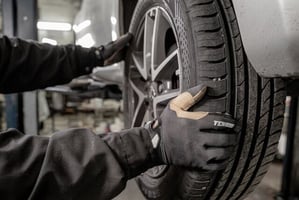When you tow, safety comes first. A hitch designed for safety does more than just hold your trailer. It controls trailer sway to protect you, your vehicle, and everyone on the road. The best safety hitches use advanced technology to eliminate sway, giving you a stable, smooth ride even in tough conditions.
If you’ve ever felt anxious about your trailer swinging or struggled with complicated setups, you’re not alone. The ProPride 3P® Hitch was created to provide reliable sway control without hassle. Its patented Pivot Point Projection™ technology keeps your trailer steady, making towing feel more like a fifth wheel than a traditional hitch.
With an adjustable design and easy installation, the ProPride system fits your needs now and in the future, making your RV trips safer and more enjoyable.
Essential Safety Features in Modern Hitches
Modern hitches focus on safety. They lock the trailer securely, alert you to problems, and help prevent accidents. These features keep your trailer stable and your journey safer.
Automatic Locking Mechanisms
Automatic locking mechanisms keep your trailer attached to your vehicle without manual checks. When you connect your hitch, this system instantly locks the hitch bar into place. This reduces the chance of the trailer coming loose due to human error or vibration.
Manufacturers use strong, durable materials for these locks to handle heavy loads and constant towing forces. ProPride 3P® hitches use wedge-style bars that fit tightly into the hitch box, preventing unwanted movement. Automatic locks give you confidence that the connection is secure every time you hitch up.
Breakaway Systems
A breakaway system activates if your trailer separates from the tow vehicle. It applies the trailer brakes to stop it from rolling away.
This system includes a small battery and a pull cable connected to the tow vehicle. If the trailer disconnects, the cable pulls a switch that triggers the brakes. This feature can stop accidents, especially in busy areas or on slopes.
A reliable breakaway system adds an extra layer of safety beyond the hitch connection.
Integrated Safety Indicators
Integrated safety indicators help you monitor your hitch connection and towing setup easily. These can be simple colored markers showing if the hitch is locked or advanced sensors that alert you to sway or shifting.
Indicators save you time and effort during hookups. Some hitches provide visual cues on the hitch head or box, so you know at a glance if something needs attention.
Clear, immediate feedback lets you catch problems early and reduces the risk of accidents from loose or misaligned hitches.
Design Standards and Certification
When you choose a hitch designed for safety, you need to understand the strict rules and tests that ensure it works well and protects you on the road. These include certifications from trusted organizations, thorough load tests, and regional law requirements that guide how hitches must be made and used.
Industry Safety Certifications
Hitches that prioritize safety have certifications from independent organizations. These certifications prove the hitch meets strict quality and safety rules.
Look for hitches certified by groups like the Society of Automotive Engineers (SAE) or the National Highway Traffic Safety Administration (NHTSA). These agencies check that the hitch handles weight properly and reduces trailer sway under different conditions.
Certifications often cover:
- Minimum material strength
- Assembly quality
- Resistance to wear and tear
These certifications mean your hitch was built to a high standard and tested for real-world use.
Load Testing Requirements
Load testing measures how much force a hitch can handle before it breaks or bends. Your hitch must support the trailer’s weight plus forces during turns, stops, and bumpy roads.
Testing includes:
- Static load tests (steady weight)
- Dynamic tests (moving forces) like braking and cornering
- Fatigue tests (long-term use)
A proper load test simulates these forces to ensure the hitch won’t deform or fail. Expect clear evidence that the hitch passed tests at or above your trailer’s total weight rating.
ProPride’s advanced designs go through rigorous load testing to ensure their hitches provide the towing stability and safety families need.
Compliance with Regional Regulations
Regulations for hitches vary by location, but you must follow the rules where you live and travel. These laws often specify how much weight a hitch can carry and require certain safety features.
For example:
- In the U.S., Federal Motor Vehicle Safety Standards (FMVSS) define hitch strength and installation rules.
- Europe and Canada have their own rules about towing safety and hitch design.
Compliance keeps your hitch safe and legal. It helps you avoid fines, insurance issues, or accidents caused by improper equipment. Before buying, confirm the hitch meets the regional certifications needed for your area and travel plans.
Best Practices for Safe Hitch Installation
When you install your hitch, precise attachment and thorough inspections matter most. The right connection keeps your trailer stable and reduces sway. Checking your hitch before every trip helps avoid accidents and costly damage.
Proper Attachment Methods
Align the hitch head to your tow vehicle’s receiver. Make sure the frame bracket fits snugly without gaps. Use the correct size hitch pin and safety clips to secure the connection.
For hitches like the ProPride 3P®, you don’t need to drill, making installation simpler and safer for your vehicle’s frame. Tighten all bolts to the manufacturer’s specs.
Adjust the offset hitch bar to match your trailer and tow vehicle heights for proper weight distribution. This reduces stress on your setup and improves towing stability.
Check that the one-piece yoke is properly seated and that the spring bars or control links are not obstructed. Avoid friction-based systems here, as they can wear out and reduce sway control.
Inspection Before Use
Before every trip, inspect every part of your hitch setup. Check the hitch head and hitch box for cracks, rust, or wear. Look for loose or missing bolts, pins, or clips.
Check the pivot point projection area to ensure it moves freely. This is crucial for an anti-sway hitch to work properly.
Examine the weight distribution system for even load sharing. Uneven weight on your trailer can worsen sway and braking.
Inspect the connection to your trailer, including safety chains and wiring plugs. Proper inspection prevents unexpected failures and keeps your towing experience smooth and safe.
For more detailed advice on installation and safety, visit ProPride’s Resources page.
Innovations Enhancing Hitch Safety
Safety in your towing setup depends on both smart design and strong materials. Towing stability comes from technology that controls sway without friction and from components built to last under tough conditions.
Smart Hitch Technology
One major innovation in towing safety is the use of advanced sway control systems that reduce trailer movement. The ProPride 3P® uses Pivot Point Projection™ technology to create a virtual pivot point. This lets the trailer turn naturally but resists side-to-side sway, unlike traditional friction hitches that just try to slow down sway.
This smart design improves your control and makes driving less stressful. You don’t feel constant jerks or trailer wobble, which are common in older hitches. With an adjustable offset hitch bar, you can easily change heights for different vehicles and trailers without needing a new hitch.
Key tech features include:
- Virtual pivot point for smooth turning
- No need for drilling during installation
- One-piece yoke replacing unreliable strut bars
These features make your towing safer and more reliable every time you hit the road.
Materials for Strength and Durability
The materials in the hitch affect how well it holds up over time and under heavy loads. ProPride builds the 3P® hitch using high-grade steel that balances strength and weight. This lets the hitch handle the stresses of towing without cracking or bending.
The frame bracket and hitch box transfer trailer forces safely to your vehicle. Manufacturers weld and machine these parts precisely to avoid weak points. Corrosion resistance is built in, so your hitch won’t fail due to rust after long use outside.
Here’s what you should expect in quality materials:
|
Feature |
Benefit |
|
High-strength steel |
Handles heavy loads safely |
|
Precise welds |
Prevents structural failure |
|
Corrosion resistance |
Lasts longer in all weather |
Strong materials and smart design help your hitch stay safe and stable trip after trip.
Frequently Asked Questions
Choosing the right hitch means looking at features that affect safety, durability, and ease of use. You’ll want to understand how various designs handle trailer sway and what parts matter most to keep your towing secure.
What features should I look for in a safe tow hitch?
Look for a hitch with anti-sway technology that prevents side-to-side trailer movement. Features like a one-piece yoke and adjustable offset hitch bar improve towing stability. Easy installation without drilling and better weight distribution are also important for safety.
How do reviews rate the safety of different hitch designs?
Reviews highlight how well hitches control trailer sway and ease of use. Hitches with patented technologies for sway control typically score higher. Users mention smoother towing and less fear of sway compared to friction-based designs.
What is the typical price range for a high-quality safety hitch?
High-quality safety hitches usually range from mid to upper price points. Expect to invest more for premium engineering that offers reliable trailer sway control and durable materials. This price reflects better safety and fewer towing issues over time.
How does a hitch safe cover enhance towing safety?
A hitch safe cover protects vital parts from weather damage and dirt. It helps maintain the hitch’s performance, which is essential for consistent sway control. Keeping components clean reduces wear and lowers the chance of hitch failure.
What are the essential parts to check when evaluating hitch safety?
Check the hitch box, hitch head, frame bracket, and control links. These parts ensure proper weight distribution and sway control. Also, inspect spring bars and the one-piece yoke for structural integrity and smooth movement.
Can a hitch safe lock box prevent theft and if so, how effective is it?
A hitch safe lock box can discourage theft by securing the hitch to your vehicle. Its effectiveness depends on build quality and fit. A strong lock box combined with an advanced hitch design provides a good layer of security for your trailer.
The ProPride 3P® hitch uses innovative technology to improve safety and security. For more details, check out ProPride’s Frequently Asked Questions.


